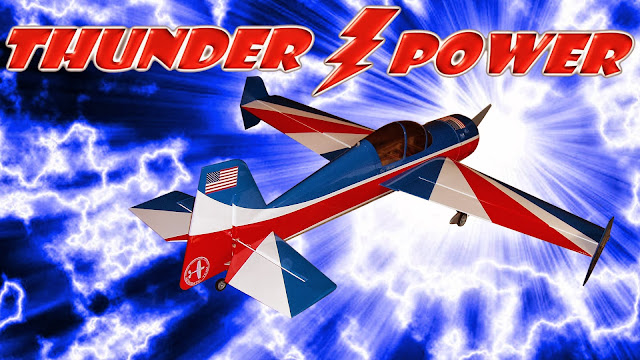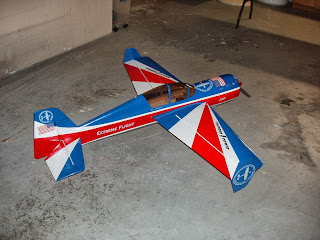Well, not exactly. They aren't quite twins.
It was a bit of a dilemma when the red and white splinter scheme Yaks became available because I had just crashed my Russian Thunder. I have always liked that scheme, but the red looked awesome too. Being unable to decide, I didn't even try, and I got them both.
You gotta have a backup, right? Except, after flying the red Yak, I also couldn't make up my mind which one I wanted to be backup. Not being able to decide, I fly them both!
Click To Enlarge
You might notice my Russian Thunder looks a little different from the others you have seen. I used the white (instead of blue) SFGs from my last (and late) red Yak to brighten up the plane's visibility. I am closing in on senior citizenship, so everything I can do to help me see the plane better is worth it. It seems to have worked well.
In later pictures you will notice I also used the red/white wheel pants from the red Yak, only I replaced the blue trim with gold 3M high performance vinyl striping. I love working with that stuff!
Dialing In The CG
First, the Yak is not temperamental or hard to set up. It just rewards you more if you take the time to get it spot on. It's also simply a different kind of plane that flies a bit differently and likes a bit different set up. None of this is hard. It's the same thing you go through with any other 3D style plane, but with the Yak, having the right set up makes it really come alive. If you are lazy, this isn't the right plane for you, but if you take the time to get it right, it's an amazing airframe.
The Yak seems to be a bit different from the other EXPs in that it is a bit less forgiving on the center of gravity (CG) location. Initially I started off nose heavy, because I generally like them a little forward of having a neutral CG. A little nose heavy makes the plane track and groove better at high speed, but it also makes 3D a little bit more difficult. Everyone seems to prefer something different, and lately I have been moving my CGs back and trying to get closer to neutral.
Once I got the CG where I liked it, then it was a matter of learning to grab that elevator and hold the nose up as high as I could get it. That was the final step in gaining complete confidence in this airframe, emphasizing once again how critical set up is on all high performance planes.
Click To Enlarge


I always suggest starting with the CG from the manual, but this time for experienced pilots, I recommend starting at the rear of what the manual calls for. That will get you really, really, close, and from there, it's a matter of personal preference where to put it. Don't be afraid to move that CG back, but do it in small increments. This way, if you get too tail heavy you can get it back down without a lot of drama, and then move the pack back forward.
I got mine too tail heavy and it was not a big deal to land, make the adjustment and then everything was perfect. I generally keep moving back until it gets too tail heavy, and then go back to where I was the flight before.
The Yak has me re-evaluating how I set the CG on my planes. I was already moving the pack back on my Extra EXPs, and now I think I am beginning to prefer something closer to a neutral CG instead of slightly ahead of that. We will have to fly and experiment more, which ain't a bad way to spend an awesome Florida October!
Click To Enlarge


With the yak having all it's thrust and flying surfaces on a central datum line, everything snaps, rolls and spins on a single axis. Since the components are not fighting each other, the Yak is a bit more agile on that axis. As a result, I have dialed my aileron end point controls back from 150% to 125%. It rolls so fast that I simply don't need that much, and I can fly it smoother with a little less throw.
One thing you will see on the following video is a crazy spin I came up with. I did it by screwing up a blender and giving it the wrong control. As with any violent maneuver, speed is your friend, so I start by diving the plane straight down, and let it build up to terminal velocity. Yes, this is hard on the airframe, but the EXPs are so hearty that they can take it.
Then, I put the plane into a full right aileron roll heading straight down. From here, the drag on the ailerons slow the plane a bit, so you only want to do two or three turns before you slam in full right rudder and down elevator, and then hang on. The Yak goes absolutely batsnitt crazy. It spins so fast that I simply can't keep up with it and it never comes out pointed where I want it too. If you try this, I heartily suggest you leave yourself a fat margin to the ground, at least the first few times.
Go to 0:45 to see the spin. This one was a bit too low, but we're shooting more video today with Russian Thunder and we'll try to get another one.
Tough choice if you can only have just one. The Russian Thunder is about as classic as it can get, though the EXP version is modernized a bit and the wing and stab have matching patterns. When the wing, stab and fin are all different patterns, that makes my OCD go a bit whacky, and severely offends my sense of symmetry. I very much like what The Boss did to make this version of Russian Thunder so pleasing to look at.
The Red Splinter scheme is also very symmetrical, though admittedly it does have a bit more visual pop. It is a very visible scheme, made even more so with the underside of the wing sharing the same checkerboard pattern with the Extra EXP. While this is a small detail, I would love to see the bottom of the red Yak's horizontal stabilizer match the wing instead of being pure white. I may cut up some black 3M high performance vinyl and slap it on my red Yak.






























